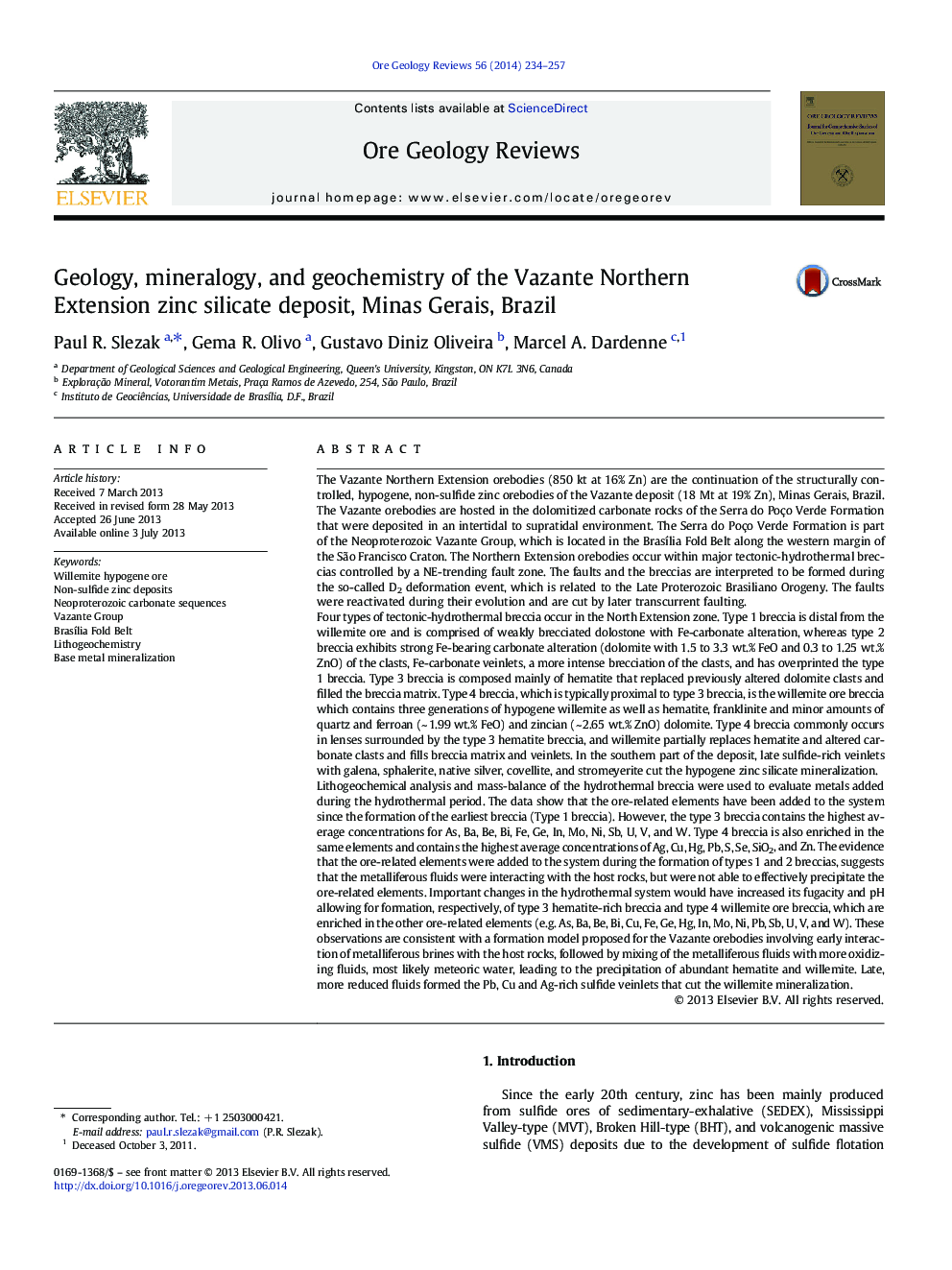| کد مقاله | کد نشریه | سال انتشار | مقاله انگلیسی | نسخه تمام متن |
|---|---|---|---|---|
| 4697432 | 1637247 | 2014 | 24 صفحه PDF | دانلود رایگان |
The Vazante Northern Extension orebodies (850 kt at 16% Zn) are the continuation of the structurally controlled, hypogene, non-sulfide zinc orebodies of the Vazante deposit (18 Mt at 19% Zn), Minas Gerais, Brazil. The Vazante orebodies are hosted in the dolomitized carbonate rocks of the Serra do Poço Verde Formation that were deposited in an intertidal to supratidal environment. The Serra do Poço Verde Formation is part of the Neoproterozoic Vazante Group, which is located in the Brasília Fold Belt along the western margin of the São Francisco Craton. The Northern Extension orebodies occur within major tectonic-hydrothermal breccias controlled by a NE-trending fault zone. The faults and the breccias are interpreted to be formed during the so-called D2 deformation event, which is related to the Late Proterozoic Brasiliano Orogeny. The faults were reactivated during their evolution and are cut by later transcurrent faulting.Four types of tectonic-hydrothermal breccia occur in the North Extension zone. Type 1 breccia is distal from the willemite ore and is comprised of weakly brecciated dolostone with Fe-carbonate alteration, whereas type 2 breccia exhibits strong Fe-bearing carbonate alteration (dolomite with 1.5 to 3.3 wt.% FeO and 0.3 to 1.25 wt.% ZnO) of the clasts, Fe-carbonate veinlets, a more intense brecciation of the clasts, and has overprinted the type 1 breccia. Type 3 breccia is composed mainly of hematite that replaced previously altered dolomite clasts and filled the breccia matrix. Type 4 breccia, which is typically proximal to type 3 breccia, is the willemite ore breccia which contains three generations of hypogene willemite as well as hematite, franklinite and minor amounts of quartz and ferroan (~ 1.99 wt.% FeO) and zincian (~ 2.65 wt.% ZnO) dolomite. Type 4 breccia commonly occurs in lenses surrounded by the type 3 hematite breccia, and willemite partially replaces hematite and altered carbonate clasts and fills breccia matrix and veinlets. In the southern part of the deposit, late sulfide-rich veinlets with galena, sphalerite, native silver, covellite, and stromeyerite cut the hypogene zinc silicate mineralization.Lithogeochemical analysis and mass-balance of the hydrothermal breccia were used to evaluate metals added during the hydrothermal period. The data show that the ore-related elements have been added to the system since the formation of the earliest breccia (Type 1 breccia). However, the type 3 breccia contains the highest average concentrations for As, Ba, Be, Bi, Fe, Ge, In, Mo, Ni, Sb, U, V, and W. Type 4 breccia is also enriched in the same elements and contains the highest average concentrations of Ag, Cu, Hg, Pb, S, Se, SiO2, and Zn. The evidence that the ore-related elements were added to the system during the formation of types 1 and 2 breccias, suggests that the metalliferous fluids were interacting with the host rocks, but were not able to effectively precipitate the ore-related elements. Important changes in the hydrothermal system would have increased its fugacity and pH allowing for formation, respectively, of type 3 hematite-rich breccia and type 4 willemite ore breccia, which are enriched in the other ore-related elements (e.g. As, Ba, Be, Bi, Cu, Fe, Ge, Hg, In, Mo, Ni, Pb, Sb, U, V, and W). These observations are consistent with a formation model proposed for the Vazante orebodies involving early interaction of metalliferous brines with the host rocks, followed by mixing of the metalliferous fluids with more oxidizing fluids, most likely meteoric water, leading to the precipitation of abundant hematite and willemite. Late, more reduced fluids formed the Pb, Cu and Ag-rich sulfide veinlets that cut the willemite mineralization.
Journal: Ore Geology Reviews - Volume 56, January 2014, Pages 234–257
